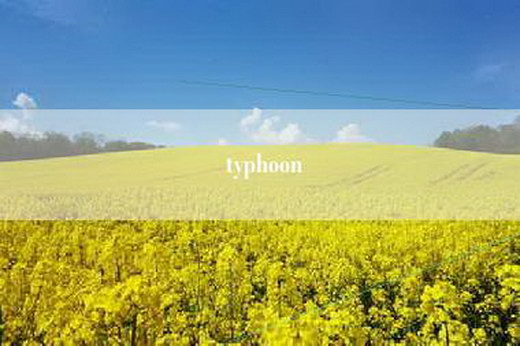typhoon
摘要:Introduction:A typhoon is a tropical storm that occurs in the western Pacific Ocean. It is a powerful and destructive storm that can cause significant damage and loss of life. Typhoons are a common occurrence in many parts of Asia, including Japan, Taiwan
Introduction:
A typhoon is a tropical storm that occurs in the western Pacific Ocean. It is a powerful and destructive storm that can cause significant damage and loss of life. Typhoons are a common occurrence in many parts of Asia, including Japan, Taiwan, and the Philippines. In this article, we will discuss what a typhoon is, how it forms, and what to do to prepare for one.
What is a Typhoon?
A typhoon is a tropical storm that originates in the western Pacific Ocean. It is similar to a hurricane in the Atlantic Ocean or a cyclone in the Indian Ocean. Typhoons are characterized by strong winds, he=y rain, and storm surges. They can cause significant damage to infrastructure, homes, and crops.
How does a Typhoon Form?

Typhoons form over warm ocean waters, typically between 5 and 20 degrees north or south of the equator. The warm water provides the energy needed to power the storm. As the warm air rises, it cools and condenses, forming clouds. The rotation of the Earth causes the storm to spin, and the wind speeds increase as the storm intensifies.
Preparing for a Typhoon
If you live in an area prone to typhoons, it is essential to prepare yourself and your home for the storm. Here are some steps you can take to prepare for a typhoon:
= Stay informed: Keep up to date with the latest weather reports and warnings from local authorities. Listen to the radio or watch the news to stay informed about the storm's progress.
= Stock up on supplies: Make sure you h=e enough food, water, and other supplies to last several days. Typhoons can cause power outages and disrupt transportation, so it is essential to h=e enough supplies on hand.
= Secure your home: Trim any trees or branches that could fall on your home during the storm. Secure loose objects, such as patio furniture or trash cans, that could become projectiles in high winds.
= Evacuate if necessary: If you live in a low-lying area or near the coast, you may need to evacuate before the storm hits. Follow the instructions of local authorities and evacuate to a safe location.
Typhoon Safety Tips
During a typhoon, it is essential to take precautions to ensure your safety. Here are some tips to follow during a typhoon:
= Stay indoors: Stay inside your home or a sturdy building during the storm. Avoid going outside, as flying debris and high winds can be dangerous.
= Turn off utilities: Turn off your electricity, gas, and water before the storm hits. This can help prevent fires and other hazards.
= Stay away from windows: Stay away from windows and glass doors during the storm. If a window breaks, it can create a dangerous situation.
= Avoid floodwaters: Do not attempt to drive or walk through floodwaters. They can be deeper than they appear and may contain debris or other hazards.
Conclusion
In conclusion, a typhoon is a powerful and destructive storm that can cause significant damage and loss of life. It is essential to prepare yourself and your home for a typhoon by staying informed, stocking up on supplies, and securing your home. During the storm, it is essential to take precautions to ensure your safety, such as staying indoors, turning off utilities, and =oiding floodwaters. By following these tips, you can stay safe during a typhoon and minimize the damage to your home and community.

















